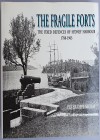The Fragile Forts: The Fixed Defences of Sydney Harbour 1788–1963
Written by Peter Oppenheim,
Australian Military History Publications, Loftus, New South Wales, 2005, 326pp.
Reviewed by: Colonel Terry McCullagh, CSC, President, Royal Australian Artillery Association (ACT)
The Fragile Forts is a joint publishing venture between the Australian Army History Unit and Australian Military History Publications and makes a valuable contribution to the rich history of the Sydney Harbour’s fixed defences. The author Peter Oppenheim, an architect by profession, taught at the School of Architecture, University of New South Wales, and spent ten years researching and writing this book. In the process of his research, Oppenheim worked closely with a number of key heritage organisations, including the National Artillery Museum at North Head and the Royal Australian Artillery Historical Company.
The author traces the history of Sydney’s fixed defences from the arrival of the first fleet and the early days of British settlement. He describes the development of Sydney’s fortifications from the colony’s fears of foreign invasion in the 19th century through the impact of the Great War of 1914–18 and the War in the South-West Pacific in World War II. The history concludes with the dismantling of the great guns that protected the harbour. The book is meticulously researched, abundantly illustrated with drawings, photographs and maps, and features a comprehensive index. Oppenheim’s descriptions are generous in their detail of ordnance and fort design. The author provides an excellent technical description of the forts and guns of Sydney Harbour. He also describes the complex military, political, social and economic factors that helped to shape the establishment of the harbour defences. In particular, Oppenheim recounts the countless reports and appreciations that were produced, and the numerous commissions and schemes that existed over the years in New South Wales relating to the defences of Port Jackson. The book is therefore an intriguing account of colonial fear and isolation, of technology and independence—an account that is told fluently and stylishly, making for compelling reading.
The Fragile Forts should cater for a broad readership, including military historians, heritage lovers, devotees of the architecture of fixed defences—such as the Martello tower on Fort Denison—and will please those artillery specialists and gunners fascinated by the vast array of ordnance around Sydney Harbour. As a study, the book makes a significant contribution to the history of Australian artillery in particular and Australia’s military history in general. It is a book that is long overdue and one that is thoroughly recommended to interested readers.

